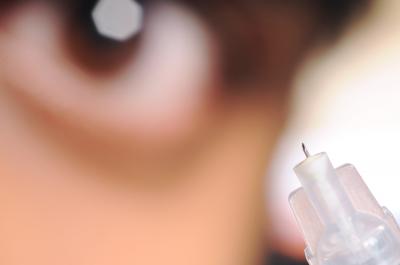 |
|
Researcher Samirkumar Patel displays a prototype microneedle. Image courtesy of Georgia Tech--Photo: Gary Meek |
Researchers from the Georgia Institute of Technology and Emory University have found that tiny microneedles could deliver drugs to the back of the eye, targeting diseases such as macular degeneration. Getting drugs into the eye isn't easy; eyedrops aren't always effective and the thought of a hypodermic needle in the eye isn't pleasant.
The researchers used microneedles less than a millimeter in length to inject a fluorescent dye, a drug (bevacizumab) and small polymer particles into the suprachoroidal space in rabbits' eyes. This is just behind the sclera (the white part of the eye) and allows drug to flow along the inner surface of the eye to the back, including the retina. To check the delivery, they tracked the levels of fluorescence, and found that not only were the florescent molecules delivered to the back of the eye and not the front, but also that the polymer particles stayed in the suprachoroidal space for extended periods. A startup, Clearside Biomedical, has been created to commercialize the technology.
"The study showed that if we inject non-degradable particles into the suprachoroidal space and wait as long as two months, the particles remain," said Mark Prausnitz of Georgia Tech's School of Chemical and Biomolecular Engineering. "That means there is no natural mechanism to remove the particles from the eye. Knowing this, we can design biodegradable particles with drugs encapsulated in them that can slowly release those drugs over a period of time that we could control."
Cases of diseases like macular degeneration are likely to increase as the population ages, and biopharma companies are developing new drugs to treat these, so delivering drugs safely, effectively and with the minimum of stress will be important. Injections into the eye with a hypodermic are daunting for the patient, risk infection and while the drug will get to the back of the eye where it is needed, it can also get to the front of the eye, leading to side effects. Eyedrops are easy and low cost, but don't always get the drug to where it is needed.
While the results from this study are positive, it's important to be aware that it is still at an early stage and involved testing only in rabbits so far. Further research needs to be carried out in humans before drawing any firm conclusions.
- see the press release
- check out the abstract in Investigative Ophthalmology & Visual Science
Like what you're reading